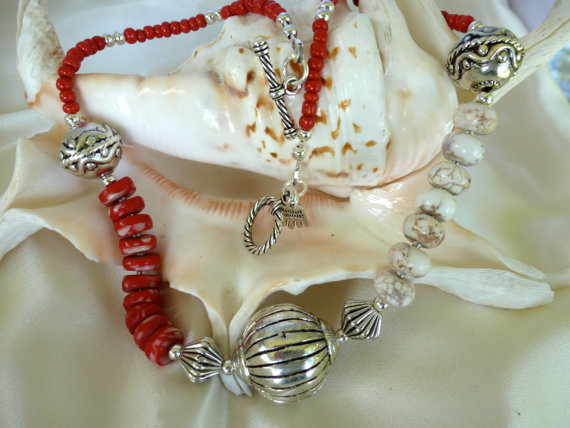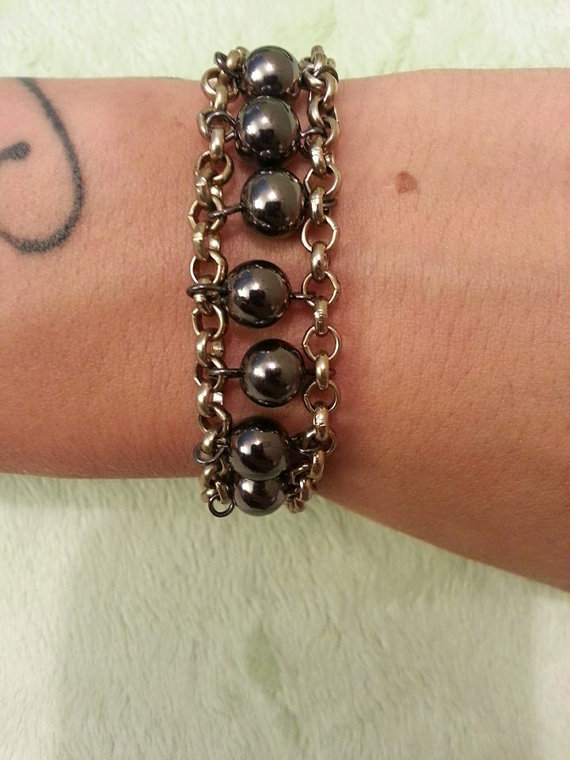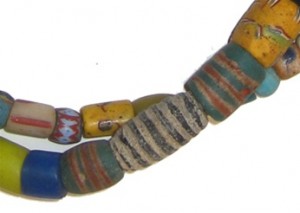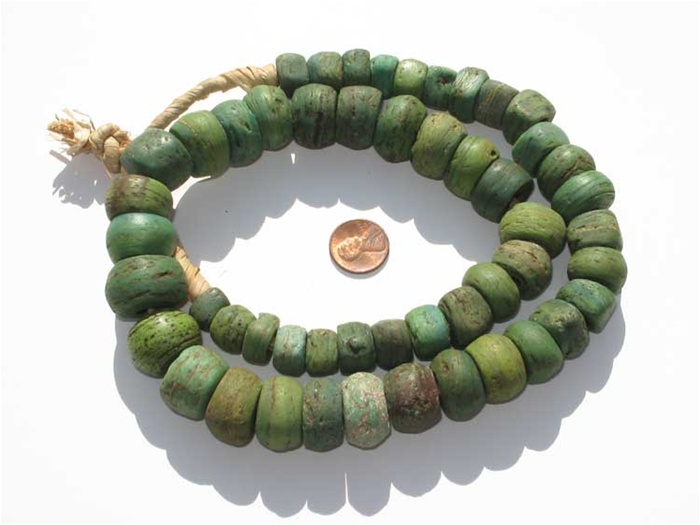3 Stylish Uses For Kakamba Prosser Beads
Prosser beads are so much more than colorful spacers. With their versatile donut shape, and myriad of two-tone color combinations, they make for beautiful focal beads whether teemed with silver chain, or wire-wrapped glass spheres. Here are a few examples which show how to incorporate them into contemporary, yet bohemian jewelry pieces.
Asymmetric Polychrome Necklace
This "Congo Kapers" necklace featured on Etsy is a classic example of how old Kakamba Prosser Beads can really give your jewelry that contemporary edge. The white of the Prosser Beads is beautifully accented by milky Howlite, a naturally occurring mineral which serves to further emphasize the marbled effect of these old trade beads. Focal silver spacers break up the a-symmetric design, creating a division between beads old and new.
Tassel Earrings
As long as tribal influences are in vogue, tassel earrings will never go out of fashion. To make them a little more visually unique and interesting, create a Prosser bead sandwich simply by threading two beads onto an eye pin, separated by a silver donut spacer in the middle. Then, create the tassels using Masaai seed beads in two colors that match your polychrome Prossers. To finish, simply attach to a fish hook ear-wire.
Dual Chain Bracelet
Chunky wrist adornments are bang on trend at the moment, and because of their size, Prosser beads make for great focal beads with this particular design. You'll need two matching strips of silver or bronze chain slightly shorter than the circumference of your wrist, coupled with approximately 11-13 Prosser beads in one color. Using eye pins, simply create a ladder of beads between the two chains, leaving a little room at each end for the bolt ring and clasp. This example from The Mad Lila at Etsy gives you an idea of the end result.
Hebron: The First Bead-making Capital of the World
Do have a favorite type of Trade Bead? While I love the diversity of Venetian Trade Beads, I have to admit that my real weaknessis for Trade Beads of little known or mysterious origin – like Hebron Beads. With their rustic worn aesthetics and tell-tale signs of age, you can't help but be a little curious about the history of these antiquated glass donuts.

Rare Antique Yellow Hebron Beads.
Hebron is a mystical holy city snuggled among the Judean Mountains in Palestine, famed for being the final resting place of Abraham, his kin and descendants. Hebron's significance as a Holy City has somewhat overshadowed its glass-blowing industry, the roots of which were established during Roman settlement of Palestine in 63 BCE. Although it's unclear when Hebron began producing beads, historical records show that glass-making factories abound from the 12th Century, producing everyday items such as oil lamps and drinking vessels for sale in the street markets.
The earliest known glass beads produced in Hebron were 'eye' beads; spotted, spherical orbs of glass in two or three colors. Aesthetically, they weren't dissimilar to the Skunk Beads produced by the Venetians in the 19th Century, and were considered particularly effective in warding off the 'evil eye'. As trade networks were established between Palestine, Egypt and Africa in the 18th Century,
Hebron's glass-makers began producing a greater variety of beads for use as trade currency. Two specific types – Hersh and Munjir - were mentioned in the 1799 journal of British explorer William George Browne, with further reference to their unusually course finish. It's entirely possible that Hersh and Munjir were early forms of what we now regard to be standard Hebron Trade Beads. Their course texture is of particular note, since glass-makers in Hebron utilized sand from the village of Bani Na'im, and sodium carbonate from the Dead Sea for production. As Palestinian merchants built trade links with Africa, the beads were exported in greater quantities – most notably to West Africa, and Kano, Nigeria. Here, locals adopted them for self-adornment – hence why they're also known as Kano Beads.
How Exotic Cornaline d’Aleppo (White Heart) Beads Got Their Name
Do you ever wonder how certain African trade beads come to get their names? The origins of most African trade beads can usually be determined by their name. For example, Dogon Beads are so called because of their popularity among the Dogon tribe of Bandiagara, Mali. But some, as I've recently come to find out, are a little more misleading.
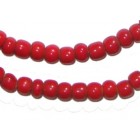
Red White Heart Beads
Cornaline d'Aleppo (commonly known as "White Heart Beads", or "Hudson Bay Beads" in America) were a popular type of wound and drawn trade bead produced between 1805 and the early 1900s in Venice, Italy. Unlike the more elaborate Millefiori Beads and Chevrons, Cornaline d'Aleppo are rather plainer in appearance, comprising just two layers of different colors. The core is usually white or off-yellow, while the outer layer (which wraps the core) is thicker, and ranges in color from burnt yellow to ruby red. A small quantity were also produced in varying shades of blue around the turn of the 20th Century, however, the most coveted were a seductive shade of dark ruby red. According to historical data, the brilliant red of Cornaline d'Aleppo Beads was the result of adding gold oxide to pink or violet glass.
So, how did they get their name? No-one can say with any great certainty why these Venetian Trade Beads came to have such an exotic name, although, it is thought that French-speaking tribespeople in Mali may have had something to do with it. The word "cornaline" is French for carnelian, a type of agate often used as currency among inter-trading tribes in Africa. "Aleppo" on the other hand, is the name of a small town in Syria. Some suggest the reference to Aleppo was inspired by the fact that it was once an important trading post between Africa and Asia. Nomadic African tribespeople would pass through the city to stock up on supplies, exchanging carnelian beads for essentials such as furs, tools and food. I prefer to believe the name derives from the magical striped stones of Aleppo, famous throughout Africa and Asia for their healing properties.
The Rise and Decline of Kakamba Prosser Beads
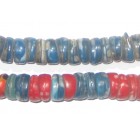
Red and Blue Kakamba Prosser Beads
The journey of a bead collector is one filled with ponderings and questions. Where do my Trade Beads come from? Who made them? Even if these tiny details don't mean much to you personally, they can have significant bearing upon your authority and commercial appeal as a jewelry artist.
Kakamba Prosser Beads are one of my most recent discoveries. I actually happened upon them whilst looking for some colorful spacers to use in my jewelry. Early Prosser Beads were named after English brothers Richard and Thomas Prosser, who devised the innovative molding technique for their production in 1840. The rights for this technique were later bought by Jean-Felix Bapterosses, a French button manufacturer who would later found one of the largest bead-producing factories in Europe. Sometime in the 1860s, Prosser Beads came to be known as “Kakamba Prosser Beads”; named after a small town in The Republic of the Congo where they were traded by merchants.
According to trade records, Africa was one of the chief markets for Prosser Beads. European traders would use them to build rapports with tribal chiefs, thus ensuring safe passage through unexplored or unknown regions. However, these merchants were shrewd types, and weren't averse to conning tribespeople in order to get what they wanted. Beads were often strung upon weak cord, which would break easily. Natives were also told it was bad luck to pick them up, thus creating a need for new beads in exchange for small favors.
Prosser Beads continued to be produced in Europe long after the death of Jean-Felix Bapterosses in 1885, however, largely fell out of favor as more elaborate beads were introduced to Africa in the early 1900s. Their sad decline in popularity eventually relegated them to the history books by the mid 20th Century – until locals in Kakamba began finding hoards of them in the ground while farming.
To think that the beads I hold today once traveled 3,000 miles from Europe to the Congo is amazing, but more fascinating still is the fact they may once have adorned the neck of a great tribal chief all those years ago. A slice of history being recycled once more for self adornment!
Zulu Beads – The Hidden Love Letters of Africa
Bead adornment has long been used for communicative purposes, although it is largely the tribes of Southern Africa whom are renowned for the complexities of this visual communication method. During the thriving merchant era, certain types of trade beads (notably Chevrons) were highly sought after due to their rarity, or intricacy, and would therefore be worn by elders, Royalty and aristocracy to signify wealth, status and governing power.
But African trade beads weren't the only variant that bore significance as a correspondence tool. Zululand, in the heart of South Africa, is also known for a complex 'language', that uses both Zulu beads, and simple symbols such as the triangle, to convey non-verbal messages. The most common use for this communication method, is for love letters, in a society where it was once frowned upon for women to initiate the courting with men.
The Zulu bead language is built around the geometric triangle - each point bearing a significance to marital status, as does the positioning. Typically, if the point faces Southward, this denotes an unmarried woman, whereas if the apex points North, this signifies an unmarried man. Variants on both the orientation of the triangle, it's attachment to another, and the color of beads it is depicted against, all have an influence upon the message conveyed. Seven main bead colors tend to be used within the bead 'language', and although they all have primary meanings (i.e black connoting sadness, dismay and death); secondary definitions and messages can be created, as a result of the context in which Zulu beads are arranged. Different hues also influence context.
The most common colors used within the Zulu code are: green, which can symbolize contentment, yet also convey envy; blue which signifies longevity and faithfulness; red is strength of emotion, so can dictate love or anger; white for purity, honesty and neutrality of spirit; and finally pink, which added emphasis to a promise, and suggestion of fertility.
With such a beautifully simple language at their fingertips, both Zulu men and women found an avenue by which they could discuss and relay affairs of the heart, without doing so in public. The creative arrangement of Zulu beads allowed for more intricate expression, giving birth to several now well known Zulu love poems. One of these is "iNcwadi" ("I-en-che-wadi"), describing black as a depression due to a lover's absence, and green as the "springing of shoots", likened to the birth of love.
Green Hebron Kano Trade Beads from Sudan
Very few African trade beads come from Sudan. But Hebron beads are one of the few that do. Also known as "Kano beads", they come in several different colors and varieties. The most common are yellow hebron beads, followed by blue hebron beads, then green hebron beads. Occasionally, collectors will come across a strand of mixed polka dot Hebron beads, but these will run $300 and upwards, per strand.
Hebron beads are said to be made with salts from the Dead Sea. The Dead Sea, located in Israel, is the saltiest sea on earth, as well as the lowest point on Earth. It is known for its ability to keep people floating, and is a top tourist attraction in the Middle East.
Green hebron trade beads date back to the mid 19th century and earlier. This is why they are a favorite of antique bead collectors. Strands can come in a graduated form, in which the beginning of the strand holds the smallest beads, and the size of the beads graduate larger and larger as you go further down the strand. Or they can come in a uniform style, in which all hebron beads are the same size and shape.
Green hebron beads typically run for $150+ per strand, or approximately $18 per bead. They are often difficult to come by, but are available on many online trade bead stores.
Use these beautiful Sudanese trade beads in your next beading project!
